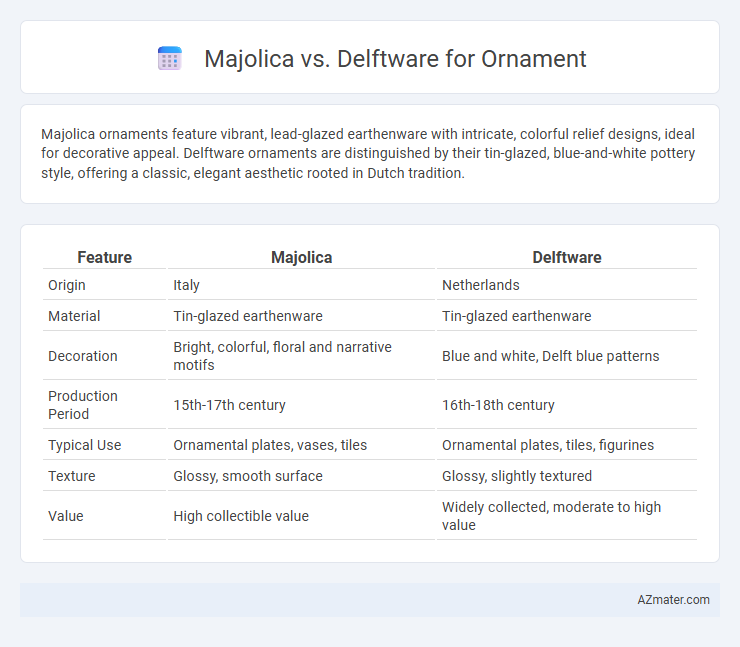Majolica ornaments feature vibrant, lead-glazed earthenware with intricate, colorful relief designs, ideal for decorative appeal. Delftware ornaments are distinguished by their tin-glazed, blue-and-white pottery style, offering a classic, elegant aesthetic rooted in Dutch tradition.
Table of Comparison
| Feature | Majolica | Delftware |
|---|---|---|
| Origin | Italy | Netherlands |
| Material | Tin-glazed earthenware | Tin-glazed earthenware |
| Decoration | Bright, colorful, floral and narrative motifs | Blue and white, Delft blue patterns |
| Production Period | 15th-17th century | 16th-18th century |
| Typical Use | Ornamental plates, vases, tiles | Ornamental plates, tiles, figurines |
| Texture | Glossy, smooth surface | Glossy, slightly textured |
| Value | High collectible value | Widely collected, moderate to high value |
Introduction to Majolica and Delftware
Majolica and Delftware are two distinctive types of ornamental ceramics known for their vibrant glazes and intricate patterns. Majolica, originating from the Italian Renaissance, features tin-glazed earthenware decorated with colorful, opaque glazes creating vivid scenes and natural motifs. Delftware, developed in the Netherlands in the 17th century, is recognized for its blue-and-white tin-glazed pottery, often depicting floral designs, pastoral landscapes, and historical narratives on a white background.
Historical Origins and Development
Majolica originated in the Italian Renaissance during the 15th century, featuring tin-glazed pottery decorated with vibrant, intricate designs inspired by Mediterranean flora and mythology. Delftware emerged in 16th-century Netherlands, influenced by Chinese porcelain, characterized by its distinctive blue and white glaze and often depicting pastoral landscapes and Dutch cultural motifs. Both types evolved through cross-cultural exchanges, with Majolica reflecting Italian artistic heritage while Delftware adapted Asian artistry to European tastes, becoming iconic in decorative ceramics.
Key Materials and Techniques
Majolica ornaments feature a tin-glazed earthenware base, coated with an opaque white glaze that enhances vibrant metallic oxides for colorful, detailed designs. Delftware uses a similar tin-glazed technique but typically employs a white or light blue glaze decorated with cobalt oxide for its characteristic blue and white patterns. Both techniques rely on high-temperature firing to fuse the glaze and pigments, creating durable, glossy surfaces ideal for intricate ornamental details.
Distinctive Artistic Styles
Majolica features vibrant, hand-painted tiles and ceramics with bold colors and intricate floral or natural motifs, reflecting Renaissance and Mediterranean influences. Delftware exhibits a distinctive blue and white palette, often showcasing delicate scenes inspired by Dutch landscapes, windmills, and floral patterns rooted in 17th-century Dutch culture. Collectors value Majolica for its rustic charm and vivid palette, while Delftware is prized for its refined elegance and historical Dutch craftsmanship.
Color Palettes and Glazing Methods
Majolica ornaments showcase vibrant, opaque color palettes achieved through tin-glazed earthenware that produces a shiny, glass-like surface enhancing intricate hand-painted designs. Delftware typically features a distinctive blue-and-white color scheme created by applying a tin glaze over a white base, with cobalt oxide used for detailed blue motifs firing to a durable, glossy finish. The glazing methods in Majolica allow for richer, multi-colored ornamentation, while Delftware's glazing emphasizes crisp, monochromatic patterns with a smooth, reflective glaze layer.
Popular Motifs and Decorative Themes
Majolica ornaments commonly feature vibrant floral patterns, mythological scenes, and intricate foliage motifs inspired by Renaissance art, emphasizing bright glazes and rich colors. Delftware decorations often showcase iconic blue and white designs with traditional Dutch scenes, windmills, tulips, and nautical themes that reflect 17th-century Dutch culture. Both types emphasize detailed hand-painted techniques but differ in color palettes and cultural symbolism, with Majolica favoring bold hues and Delftware showcasing monochrome elegance.
Regional Influences and Cultural Significance
Majolica ceramics, originating from Italian Renaissance traditions, showcase vibrant tin-glazed pottery with intricate floral and mythological motifs reflecting Mediterranean cultural influences. Delftware, produced primarily in the Netherlands during the 17th century, exhibits blue-and-white designs inspired by Chinese porcelain, embodying Dutch mercantile wealth and maritime prominence. Both styles serve as cultural artifacts, representing regional aesthetics and historical trade connections in European decorative arts.
Durability and Maintenance Considerations
Majolica exhibits a robust earthenware body with a lead glaze that offers moderate durability but requires cautious handling to prevent chipping. Delftware, typically made from tin-glazed earthenware, has a relatively softer surface prone to scratches and more susceptible to crazing over time, demanding gentle cleaning methods. Both ornaments benefit from careful maintenance, yet Majolica's glaze provides slightly better resistance to moisture and stains compared to the more delicate glaze of Delftware.
Collectibility and Market Value
Majolica and Delftware each hold distinct positions in the collectible ceramics market, with Majolica prized for its vibrant, lead-glazed earthenware exhibiting intricate relief designs, driving strong demand among Victorian-era enthusiasts. Delftware, known for its iconic blue-and-white tin-glazed pottery originating from 16th-century Dutch craftsmanship, commands high market value for authentic pieces, particularly those with historical provenance and fine hand-painted details. Collectors seek Majolica for its colorful artistry and unique forms, whereas Delftware attracts investors prioritizing rarity and traditional Dutch cultural significance, influencing overall market prices and trends.
Choosing Between Majolica and Delftware for Ornamentation
Majolica and Delftware both offer unique ornamental qualities, with Majolica known for its vibrant, colorful glazes and intricate natural motifs, while Delftware features traditional blue and white designs inspired by Dutch pottery. When choosing between the two for ornamentation, consider the setting and desired aesthetic: Majolica enhances rustic, lively spaces with its bold and earthy palette, whereas Delftware suits classic, elegant interiors due to its refined monochromatic style. Durability and glazing techniques also impact maintenance, as Majolica's thick, colorful enamel may chip more easily compared to the typically smoother and more robust Delftware surface.

Infographic: Majolica vs Delftware for Ornament
 azmater.com
azmater.com